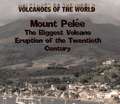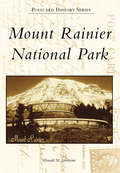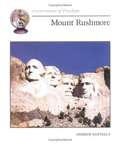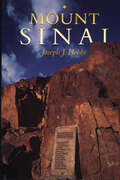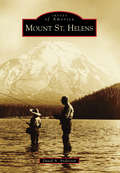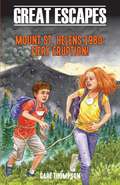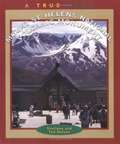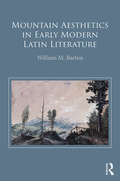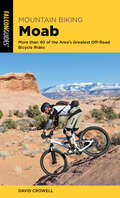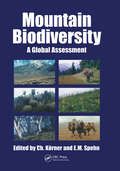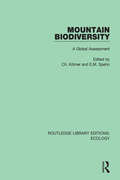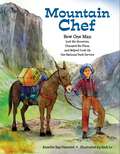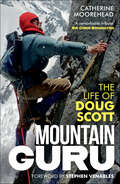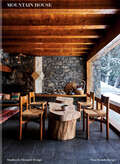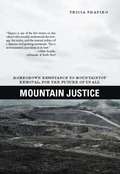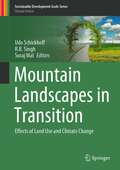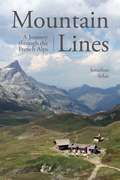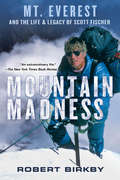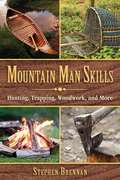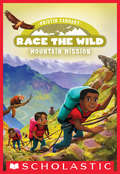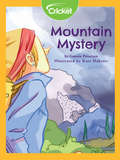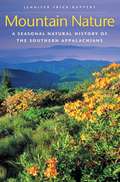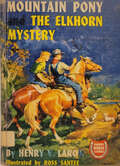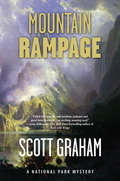- Table View
- List View
Mount Pelee: The Biggest Volcano Eruption of the 20th Century
by Kathy FurgangThis 1902 eruption occurred on the Caribbean island of Martinique. Only two of the 30,000 residents of the town of St. Pierre survived this blast. It was the first eruption that gave scientists a chance to observe the damage shortly after the event.
Mount Rainier National Park (Postcard History)
by Donald M. JohnstoneMount Rainier rises 14,410 feet above sea level and can be seen on any given day by over three million people and from over 100 miles away. It is America's fifth national park, established in 1899. The mountain is an active but currently dormant volcano. With 25 named glaciers, 50 smaller unnamed glaciers, and numerous perennial snowfields, Mount Rainier boasts the largest glacier system in the continental United States. In addition to the glacier zone, the park has alpine and subalpine forest and subtropical rain forest. Each zone has its own unique ecology of plants and animals. The vistas of and from the mountain are some of the most spectacular in all of the park system.
Mount Rushmore (Cornerstones of Freedom)
by Andrew SantellaRelates how the Mount Rushmore National Memorial, known as "The Shrine of Democracy," was conceived, designed, and created.
Mount Sinai
by Joseph J. HobbsAmid the high mountains of Egypt's southern Sinai Peninsula stands Jebel Musa, "Mount Moses," revered by most Christians and Muslims as Mount Sinai. (Jewish tradition holds that Mount Sinai should remain terra incognita, unlocated, and does not associate it with this mountain. ) In this fascinating study, Joseph Hobbs draws on geography and archaeology, Biblical and Quranic accounts, and the experiences of people ranging from Christian monks to Bedouin shepherds to casual tourists to explore why this mountain came to be revered as a sacred place and how that very perception now threatens its fragile ecology and its sense of holy solitude. After discussing the physical characteristics of Jebel Musa and the debate that selected it as the most probable Mount Sinai, Hobbs fully describes all Christian and Muslim sacred sites around the mountain. He views Mount Sinai from the perspectives of the centuries-long inhabitants of the region--the monks of the Monastery of St. Katherine and the Jabaliya Bedouins--and of tourists and pilgrims, from medieval Europeans to modern travelers dispirited by Western industrialization. Hobbs concludes his account with the recent international debate over whether to build a cable car on Mount Sinai and with an unflinching description of the negative impact of tourism on the delicate desert environment. His book raises important, troubling questions for everyone concerned about the fate of the earth's wild and sacred places.
Mount St. Helens
by David A. AndersonThe story of Mount St. Helens is that of an active volcano and human interaction with it. The mountain is culturally important to the regional native people. Its Cowlitz name, Lawetlat'la, means "Person From Whom Smoke Comes." Early European settlers saw opportunities to make a living from the natural resources, and people fell in love with the forested valleys and slopes of the glacier-clad peak with the blue lake at its foot. Forgotten were the eruptions of the 19th century and the fact that the landscape was a product of frequent violent explosions. A report from the 1970s reminded locals that Mount St. Helens is an active volcano and could erupt again before the end of the 20th century. Only a few people at that time were aware of what the mountain was capable of, and many were surprised at the events that took place in 1980.
Mount St. Helens 1980: Fiery Eruption! (Great Escapes Series)
by Gare ThompsonThis thrilling new series of books has everything middle school readers long for: action, adventure, danger, and young heroes!Great Escapes explores real historical events and shows children how kids just like them learn how to work together in order to change the world for the better. Historical figures are interwoven into the stories, offering readers the chance for further exploration on these people and their places in history. In Mount St. Helen's 1980: Fiery Eruption!, Alex and Wendy love exploring this beautiful volcano. But when the long-dormant volcano erupts, the two best friends must race to save others—and themselves.
Mount St. Helens National Volcanic Monument (True Books-National Parks)
by Sharlene Nelson Ted NelsonNIMAC-sourced textbook <P><P>Describes the destruction caused by the eruption of Mount St. Helens in 1980. <P><P>Lexile Measure: 820L
Mountain Aesthetics in Early Modern Latin Literature
by William M. BartonIn the late Renaissance and Early Modern period, man’s relationship to nature changed dramatically. An important part of this change occurred in the way that beauty was perceived in the natural world and in the particular features which became privileged objects of aesthetic gratification. This study explores the shift in aesthetic attitude towards the mountain that took place between 1450 and 1750. Over the course of these 300 years the mountain transformed from a fearful and ugly place to one of beauty and splendor. Accepted scholarly opinion claims that this change took place in the vernacular literature of the early and mid-18th century. Based on previously unknown and unstudied material, this volume now contends that it took place earlier in the Latin literature of the late Renaissance and Early Modern period. The aesthetic attitude shift towards the mountain had its catalysts in two broad spheres: the development of an idea of ‘landscape’ in the geographical and artistic traditions of the 16th century on the one hand, and the increasing amount of scientific and theological investigation dedicated to the mountain on the other, reaching a pinnacle in the late 17th and early 18th centuries. The new Latin evidence for the change in aesthetic attitude towards the mountain unearthed in the course of this study brings material to light which is relevant for the current philosophical debate in environmental aesthetics. The book’s concluding chapter shows how understanding the processes that produced the late Renaissance and Early Modern shift in aesthetic attitude towards the mountain can reveal important information about the modern aesthetic appreciation of nature. Alongside a standard bibliography of primary literature, this volume also offers an extended annotated bibliography of further Latin texts on the mountains from the Renaissance and Early Modern period. This critical bibliography is the first of its kind and constitutes an essential tool for further study in the field.
Mountain Biking Moab: More than 40 of the Area's Greatest Off-Road Bicycle Rides (Regional Mountain Biking Series)
by David CrowellTheMountain Biking Moab Pocket Guide gives fat-tire enthusiasts the skinny on where to ride in this southwestern Mecca for mountain biking. The best rides around Moab, in Canyonlands and Arches national parks, high in the La Sals, and along the Colorado River are all covered in this handy pocket-size guidebook. Detailed ride descriptions make it easy to find the trailheads and follow the routes, with easy-to-read maps and ratings for physical and technical difficulty. This guide will help mountain bikers choose a ride that's appropriate for their fitness and skill level and is an indispensable companion for all their fat-tire fun.
Mountain Biodiversity: A Global Assessment
by Ch. Körner E. M. SpehnThis book is the result of the first global conference on mountain biodiversity, and is a contribution to the International Year of Mountains, 2002. The Global Mountain Biodiversity Assessment program is a Special Target Area Region project of DIVERSITAS (UNESCO and UNEP). Biological diversity is essential for the integrity of mountain ecosystems and this dependency is likely to increase as environmental (climate) and social conditions change. Steep terrain and climate, and severe land-use pressure cause mountain ecosystems to rank among the world's most endangered landscapes. The 28 chapters in this book represent research on the biological riches in all major mountain ranges of the world, and synthesize existing knowledge on mountain biodiversity - from diversity of bacteria, plants and animals to human diversity. The book is divided into five sections: an introduction providing an overview of the issues; plant and animal diversity; climate change and mountain biodiversity; land use and conservation; and a synthesis.
Mountain Biodiversity: A Global Assessment (Routledge Library Editions: Ecology #7)
by Ch. Körner E. M. SpehnOriginally published in 2002, Mountain Biodiversity deals with the biological richness, function and change of mountain environments. The book was birthed from the first global conference on mountain biodiversity and was a contribution to the International Year of Mountains in 2002. The book examines biological diversity as essential for the integrity of mountain ecosystems and argues that this dependency is likely to increase as environmental climates and social conditions change. This book seeks to examine the biological riches of all major mountain ranges, from around the world and using existing knowledge on mountain biodiversity, examines a broad range of research in diversity, including that of plants, animals, human and bacterial diversity. The book also examines climate change and mountain biodiversity as well as land use and conservation.
Mountain Chef: How One Man Lost His Groceries, Changed His Plans, and Helped Cook Up the National Park Service
by Annette Bay PimentelThe true story of a Chinese American mountain man who fed thirty people for ten days in the wilderness--and helped inspire the creation of the National Park Service. Tie Sing was born in the mountains. The mountains were in his blood. But because he was of Chinese descent at a time in America when to be Chinese meant working in restaurants or laundries, Tie Sing&’s prospects were limited. But he had bigger plans. He began cooking for mapmakers and soon built a reputation as the best trail cook in California. When millionaire Stephen Mather began his quest to create a national park service in 1915, he invited a group of influential men—writers, tycoons, members of Congress, and even a movie star—to go camping in the Sierras. Tie Sing was hired to cook. Tie Sing planned diligently. He understood the importance of this trip. But when disaster struck—twice!—and Tie Sing&’s supplies were lost, it was his creative spirit and quick mind that saved the day. His sumptuous menus had to be struck and Tie Sing had to start over in order to feed the thirty people in the group for ten whole days. His skills were tested and Tie Sing rose to the challenge. On the last night, he fed not just the campers' bodies, but also their minds, reminding them to remember and protect the mountains. 2016 marks the 100th anniversary of the National Park Service, created by Congress on August 25, 1916. Today, you can hike to Sing Peak, named for Tie Sing, in Yosemite National Park.
Mountain Guru: The Life of Doug Scott
by Catherine MooreheadDoug Scott was a legend among mountaineers. His expeditions, undertaken over a period of five decades, are unparalleled achievements. This book describes the extraordinary drama of them all, from the Himalaya to New Zealand, Patagonia, Yosemite and Alaska. It includes his famous ‘epic’ on The Ogre, one of the hardest peaks in the world to climb, his ascent of Kangchenjunga without supplementary oxygen and his ascent, with Dougal Haston, of Everest in 1975. Catherine Moorehead also uncovers the elusive man behind the obsessive mountaineer. From his rumbustious youth in Nottingham through two tempestuous marriages to a secure third marriage, she shows how Scott matured in thought and action as his formidable global reputation increased. In doing so she reveals him to be a clash of opposites, an infuriating monomaniac who took extraordinary risks yet who developed a deep interest in Buddhism and inspired widespread affection. Scott spent almost as long as his climbing career in founding and developing Community Action Nepal, providing schools and health posts in remote parts of Nepal, where he is still much revered. Doug Scott died in 2020.
Mountain House: Studies in Elevated Design
by Nina FreudenbergerA photographic study of more than twenty houses and the mountain landscapes, from alpine forests to urban peaks, that embrace them. Spanning continents and climates, the twenty homes presented in interior designer Nina Freudenberger&’s latest book challenge and expand the idea of what a mountain house might be. Artist retreats in Morocco&’s High Atlas and the snowy folds of the Engadine Valley in Switzerland speak to the long tradition of mountains spaces for contemplation and creation, while modernist masterworks in Cape Town and Rio de Janeiro expand the traditional image of log cabins and rustic chalets. Depicted in over 200 images, these houses include brutalist lodges, clapboard cottages, and minimalist prisms set down among some of the world&’s most dramatic landscapes. In their spectacular diversity, they express the radical ingenuity and stunning creativity that the mountains have always inspired.
Mountain Justice
by Tricia Shapiro"Shapiro is one of the few writers on this subject that actually understands the strategy, the tactics, and the internal politics of a dynamic and growing movement. This is environmental journalism at it best."-Mike Roselle, Earth First! founder and author of Tree SpikerMountaintop removal (MTR) does exactly what it says: a mountaintop is stripped of trees, blown to bits with explosives, then pushed aside by giant equipment-all to expose a layer of coal to be mined. Hundreds of thousands of acres of ancient forested mountains have been "removed" this way and will never again support the biologically rich and diverse forest and stream communities that evolved there over millions of years-all to support our flawed national energy policy.Mountain Justice tells a terrific set of firsthand stories about living with MTR and offers on-the-scene-and behind-the-scenes-reporting of what people are doing to try to stop it. Tricia Shapiro lets the victims of mountaintop removal and their allies tell their own stories, allowing moments of quiet dignity and righteous indignation to share center stage. Includes coverage of the sharp escalation of anti-MTR civil disobedience, with more than 130 arrests in West Virginia alone during the first year of the Obama administration.Tricia Shapiro has been closely following and writing about efforts to end large-scale strip mining for coal in Appalachia since 2004. She now lives on a remote mountain homestead in western North Carolina, near the Tennessee border.
Mountain Landscapes in Transition: Effects of Land Use and Climate Change (Sustainable Development Goals Series)
by R. B. Singh Udo Schickhoff Suraj MalThis book compiles available knowledge of the response of mountain ecosystems to recent climate and land use change and intends to bridge the gap between science, policy and the community concerned. The chapters present key concepts, major drivers and key processes of mountain response, providing transdisciplinary orientation to mountain studies incorporating experiences of academics, community leaders and policy-makers from developed and less developed countries. The book chapters are arranged in two sections. The first section concerns the response processes of mountain environments to climate change. This section addresses climate change itself (past, current and future changes of temperature and precipitation) and its impacts on the cryosphere, hydrosphere, biosphere, and human-environment systems. The second section focuses on the response processes of mountain environments to land use/land cover change. The case studies address effects of changing agriculture and pastoralism, forest/water resources management and urbanization processes, landscape management, and biodiversity conservation. The book is designed as an interdisciplinary publication which critically evaluates developments in mountains of the world with contributions from both social and natural sciences.
Mountain Lines: A Journey through the French Alps
by Jonathan ArlanA New York Times best summer travel book recommendationA nonfiction debut about an American’s solo, month-long, 400-mile walk from Lake Geneva to Nice. In the summer of 2015, Jonathan Arlan was nearing thirty. Restless, bored, and daydreaming of adventure, he comes across an image on the Internet one day: a map of the southeast corner of France with a single red line snaking south from Lake Geneva, through the jagged brown and white peaks of the Alps to the Mediterranean sea?a route more than four hundred miles long. He decides then and there to walk the whole trail solo. Lacking any outdoor experience, completely ignorant of mountains, sorely out of shape, and fighting last-minute nerves and bad weather, things get off to a rocky start. But Arlan eventually finds his mountain legs?along with a staggering variety of aches and pains?as he tramps a narrow thread of grass, dirt, and rock between cloud-collared, ice-capped peaks in the High Alps, through ancient hamlets built into hillsides, across sheep-dotted mountain pastures, and over countless cols on his way to the sea. In time, this simple, repetitive act of walking for hours each day in the remote beauty of the mountains becomes as exhilarating as it is exhausting.Mountain Lines is the stirring account of a month-long journey on foot through the French Alps and a passionate and intimate book laced with humor, wonder, and curiosity. In the tradition of trekking classics like A Short Walk in the Hindu Kush, The Snow Leopard, and Tracks, the book is a meditation on movement, solitude, adventure, and the magnetic power of the natural world.
Mountain Lions (Falcon Pocket Guides)
by Jack BallardMountain Lions presents readers with substantive yet easily digestible information on these mysterious big cats. Where do mountain lions live? What enemies do they have? How do they communicate? What issues exist in the sometimes controversial relationship between mountain lions and humans?This book contains all the information you need to know to become familiar with these fascinating animals. Accompanied by numerous full-color photos of mountain lions in their habitat, this handy field guide makes an excellent take-home souvenir and reference for anybody interested in these big cats.
Mountain Madness: Scott Fischer, Mount Everest, and a Life Lived on High
by Robert Birkby“An extraordinary life.”—The New York Times Book Review “A fitting homage to one of the great outdoor extremists.”—Kirkus Reviews Legendary climber Scott Fischer found in Mount Everest a perfect landscape for his fearless spirit. Scaling the world’s highest peak tested his skills, his courage, and his endurance. His legendary final expedition—and its tragic outcome—are portrayed in Everest, the 3-D movie adaptation starring Jake Gyllenhaal as Scott Fischer. Robert Birkby, one of Scott’s close friends, captures in this intimate and stirring portrait who Scott Fischer really was and what led him to climb to the top of the world—before he left it altogether. “A personal, uncritical biography that rounds out the portrait of Fischer sketched in Krakauer’s best-seller Into Thin Air.”—The New York Times Book Review “A much fuller picture of a climber widely critiqued in the high-profile coverage after the Everest tragedy.”—Seattle Post Intelligencer “A vivid portrait of a superb athlete whose love of mountain climbing drove everything he did.”—Ed Viesturs, author of No Shortcuts to the Top “Birkby succeeds in illuminating the power mountains can exert over the human soul.—Publishers Weekly Updated with a New Introduction and EpiloguePlus new photos exclusive to the digital edition!
Mountain Man Skills: Hunting, Trapping, Woodwork, and More
by Stephen BrennanCrafts and Skills of the Mountain Man is a fascinating, practical guide to the skills that have made the mountain men famous worldwide as outdoorsmen and craftsmen. Readers can replicate outdoor living by trying a hand at making rafts and canoes, constructing tools, and living off the land.Learn key skills like:Building a strong fire.Learning to hunt and butcher your meals.Creating a safe and solid shelter.And much more!Whether you’re an avid outdoorsman or a novice hiker, Crafts and Skills of the Mountain Man is your handbook to not only surviving outdoors, but flourishing. The style of the mountain man is unique and popular, especially among young people, historians, and those with a special interest in living off the land. The mountain man has been successful outdoors for ages, and now you can too with the skills, tips, and tricks included in this handy manual.Skyhorse Publishing is proud to publish a broad range of books for hunters and firearms enthusiasts. We publish books about shotguns, rifles, handguns, target shooting, gun collecting, self-defense, archery, ammunition, knives, gunsmithing, gun repair, and wilderness survival. We publish books on deer hunting, big game hunting, small game hunting, wing shooting, turkey hunting, deer stands, duck blinds, bowhunting, wing shooting, hunting dogs, and more. While not every title we publish becomes a New York Times bestseller or a national bestseller, we are committed to publishing books on subjects that are sometimes overlooked by other publishers and to authors whose work might not otherwise find a home.
Mountain Mission (Race the Wild #6)
by Kristin EarhartOn a once-in-a-lifetime race through the animal kingdom, it takes smarts, strength, and skill to win!The team is climbing to new heights!The last leg of the race lands teams in the Himalayas, one of the most treacherous mountain ranges in the world. But when a rockslide disaster threatens an old friend, Russell and the team must decide whether to go on a rescue mission or race for the win...
Mountain Mystery
by Connie PettersenLaura and her cousin Cassie are on a day hike when they get caught in a rainstorm and a mysterious stranger comes to their aid...
Mountain Nature
by Jennifer Frick-RuppertThe Southern Appalachians are home to a breathtakingly diverse array of living things--from delicate orchids to carnivorous pitcher plants, from migrating butterflies to flying squirrels, and from brawny black bears to more species of salamander than anywhere else in the world. Mountain Nature is a lively and engaging account of the ecology of this remarkable region. It explores the animals and plants of the Southern Appalachians and the webs of interdependence that connect them.Within the region's roughly 35 million acres, extending from north Georgia through the Carolinas to northern Virginia, exists a mosaic of habitats, each fostering its own unique natural community. Stories of the animals and plants of the Southern Appalachians are intertwined with descriptions of the seasons, giving readers a glimpse into the interlinked rhythms of nature, from daily and yearly cycles to long-term geological changes. Residents and visitors to Great Smoky Mountains or Shenandoah National Parks, the Blue Ridge Parkway, or any of the national forests or other natural attractions within the region will welcome this appealing introduction to its ecological wonders.
Mountain Pony and the Elkhorn Mystery: Mountain Pony #4 (Famous Horse Stories)
by Henry V. LaromAn old prospector has died,and his rumored wealth is nowhere to be found. Judging from the number of mysterious visitors on Andy Marvin's newly acquired ranch, there are a lot of people who think the treasure is buried there. When Andy and Sally learn the secret of the first elkhorn tie slide, a dangerous race begins. Older boys and girls will welcome this new Mountain Pony novel, and read with special excitement the vivid, frightening scenes of the great forest fire which isolates the holders of the last clue. All of the original characters are here, with a newcomer to the series too, the exuberant little white terrier puppy named Pocket.
Mountain Rampage
by Scott Graham"Graham's clever tale is tailor-made for those who prefer their mysteries under blue skies..."-KIRKUS"Description and dialogue balance to bring both the rounded characters and the Rocky Mountain setting alive in this tale of danger, death, and intrigue...Scott Graham has created a satisfying and suspenseful adventure."-FOREWORD REVIEWS"Filled with murder and mayhem, jealousy and good detective work-set against a stunning Colorado backdrop-Mountain Rampage is an exciting, non-stop read. I look forward to more good tales from this talented author."-ANNE HILLERMAN, New York Times bestselling author of Spider Woman's Daughter"In Mountain Rampage, Scott Graham delivers taut writing, solid plot twists, a cast of interesting characters, and an appealing protagonist both men and women will love. Get ready for a leave-you-breathless high country southwestern adventure."-MICHAEL MCGARRITY, New York Times bestselling author of Hard Country and Backlands"Move over Nevada Barr-clean prose and confident storytelling combine to make Scott Graham's second Chuck Bender/National Park Mystery Series novel a must-read for fans of Western outdoor fiction and for mystery lovers everywhere."-CHUCK GREAVES, author of Hush Money, Green-Eyed Lady, and The Last Heir"In archaeologist Chuck Bender, Scott Graham has created a flawed, all-too-human, and memorable investigator who had me rooting for him to the end."-MARGARET COEL, author of Night of the White BuffaloIn the riveting second installment of the National Park Mystery Series, archaeologist Chuck Bender finds himself and his young wife and stepdaughters in the crosshairs of an unknown killer when he defends his brother-in-law from false accusations of murder in the brutal slaying of a resort worker in Rocky Mountain National Park.Scott Graham is author of Canyon Sacrifice: A National Park Mystery and Extreme Kids, winner of the National Outdoor Book Award. He is an avid outdoorsman and amateur archaeologist who enjoys hunting, rock climbing, skiing, backpacking, mountaineering, river rafting, and whitewater kayaking with his wife, an emergency physician, and their two sons. Graham lives in Durango, Colorado.
